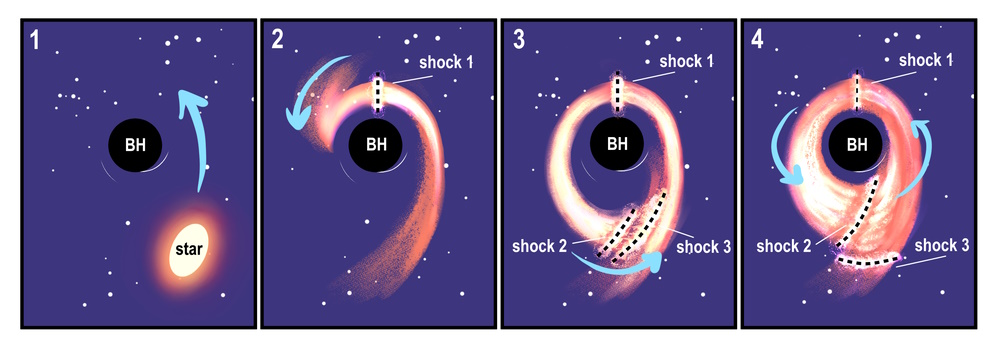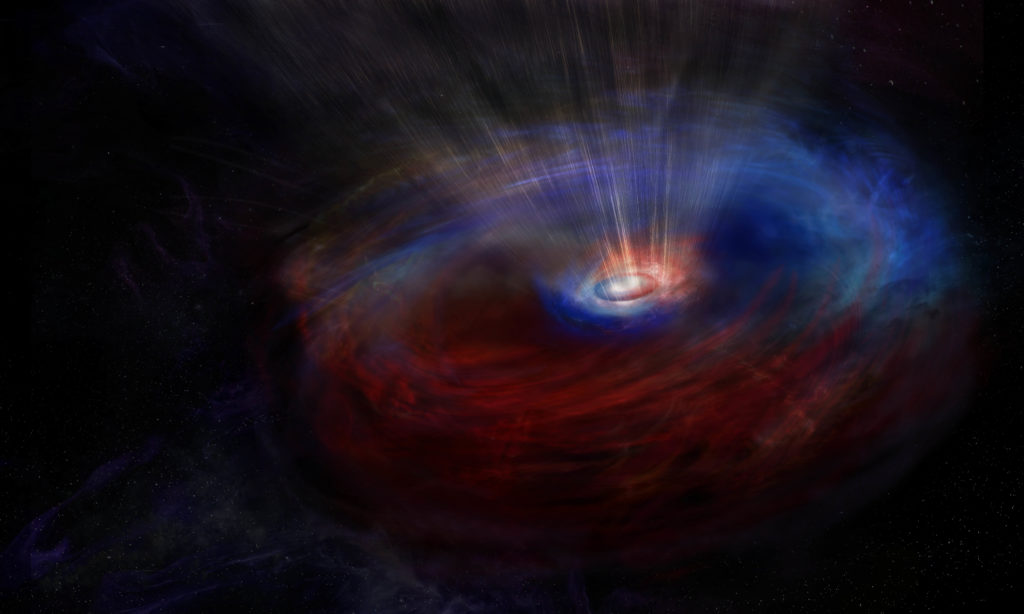A new image from the Event Horizon Telescope (EHT) collaboration— which includes scientists from the Center for Astrophysics | Harvard & Smithsonian (CfA)— has uncovered strong and organized magnetic fields spiraling from the edge of the supermassive black hole Sagittarius A* (Sgr A*). Seen in polarized light for the first time, this new view of the monster lurking at the heart of the Milky Way Galaxy has revealed a magnetic field structure strikingly similar to that of the black hole at the center of the M87 galaxy, suggesting that strong magnetic fields may be common to all black holes. This similarity also hints toward a hidden jet in Sgr A*.
Tag: supermassive black hole
An Enigmatic Cosmic Crime Scene
During a dive through archival data, astronomers unearth an unusual tidal disruption event that occurred in a nearby star-forming galaxy. Obscured by the interstellar medium, this incredibly close and luminous event went unnoticed for seven years. The SOAR telescope’s integral role in pinpointing its uncommon location illustrates how future searches for tidal disruption events will be conducted.

Tidal shocks can light up the remains of a star being pulled apart by a black hole
A new study sheds light on the bright outbursts of radiation that are created when a star is destroyed by a supermassive black hole. The outbursts do not necessarily form in the close vicinity of the black hole, but are created by tidal shocks that occur when gas from the destroyed star hits itself while circling the black hole.
NSF Telescopes Image M87’s Supermassive Black Hole and Massive Jet Together for the First Time
Scientists studying the supermassive black hole at the heart of the M87 galaxy have revealed the origins of the monster’s powerful jet and imaged the jet and its source together for the first time. What’s more, the observations have revealed that the black hole’s ring is much larger than scientists previously believed.
Researchers spot rare luminous jet spewed by supermassive black hole
A University of Minnesota Twin Cities assistant professor is co-leading a team that discovered a bright optical flare which may help researchers better understand the physics of supermassive black holes billions of light years away.
Astrophysicists Hunt for Second-Closest Supermassive Black Hole
As massive as the black hole at the center of the Milky Way, the behemoth is hosted by a dwarf galaxy less than 1 million light-years away. Invisible so far — maybe not for long.
Multi-wavelength Observations Reveal Impact of Black Hole on M87 Galaxy
A multiwavelength campaign of observations gave astronomers a “big picture” view of the region near the galaxy M87’s supermassive black hole and also the distant regions it affects.

Going Against the Flow Around a Supermassive Black Hole
At the center of a galaxy called NGC 1068, a supermassive black hole hides within a thick doughnut-shaped cloud of dust and gas. When astronomers used the Atacama Large Millimeter/submillimeter Array (ALMA)
to study this cloud in more detail, they made an unexpected discovery that could explain why supermassive black holes grew so rapidly in the early Universe.
“Thanks to the spectacular resolution of ALMA, we measured the movement of gas in the inner orbits around the black hole,” explains Violette Impellizzeri of the National Radio Astronomy Observatory (NRAO), working at ALMA in Chile and lead author on a paper published in the Astrophysical Journal. “Surprisingly, we found two disks of gas rotating in opposite directions.”